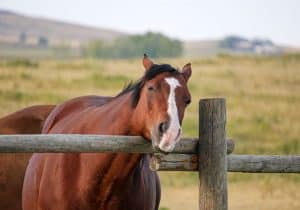Suppressing Undesirable Behavior in Mares

We usually pick up on behavioral problems in performance mares when they’re not training or performing up to our envisioned or expected potential. While almost invariably we blame the ovaries and estrus for her lack of focus or abnormal behavior, in most instances other factors are at play. Differentiating these from reproductive problems is essential to correcting the issue.
Undesirable behavior might be related to physical abnormalities, training problems, or estrous cycle activity. Common complaints from mare owners include back pain, attitude changes, tail-swishing, aggression, kicking, excessive urination, reluctance to move forward under saddle or be separated from other horses, and sensitivity to being touched.
When trying to pinpoint the cause, your veterinarian will gather a detailed history to determine when the behavior occurs. Be sure to provide a description of the undesirable behavior and whether it is continuous, intermittent, or cyclic. Your veterinarian will then perform a physical examination and supplemental diagnostics to rule out causes such as back pain, lameness, gastric ulcers, urinary tract infections, or dental pain. While more difficult to diagnose, your veterinarian will also consider fear, submissive behavior, or response to handling and training as possible causes.

To determine if estrus or reproductive issues are causing behavioral problems, observe whether the behavior is actually associated with estrus or an abnormal reproductive exam. Note when the behavior occurs relative to estrus, training, or exposure to other horses, and have your veterinarian conduct a reproductive examination when the behavior is most severe. The most common reproductive condition associated with undesirable behavior is a granulosa cell tumor in an ovary.
Once you and your veterinarian have pinpointed reproductive pathology (disease or damage) as the cause of the unwanted behavior, it’s usually possible to control or alleviate it by removing the affected ovary or suppressing estrus.
Exogenous progesterone or progestins (the estrous cycle’s dominant hormones) therapy is one of the most common estrous suppression methods in mares. Daily oral administration of the synthetic progestin altrenogest (e.g., Regu-Mate, OvaMed, Altren) is very effective and considered the gold standard. Oral altrenogest’s advantages include ease of administration, constant blood progestin levels, and no effect on future fertility. The downsides include the cost of long-term administration, inconvenience of daily dosing, and health risk to humans if absorbed through the skin. Veterinarians have administered other synthetic progestins with mixed results.
Giving multiple doses of the ovulation induction agent deslorelin acetate (e.g., SucroMate, Ovuplant) might delay estrus, but more research is needed to determine if long-term suppression is possible.
Another way to suppress estrus is to prolong the mare’s corpus luteum (CL) function—that of the structure responsible for producing progesterone post-ovulation. This causes the CL to secrete progesterone continuously, blocking estrous behavior. Methods of extending CL function include the veterinarian inserting a device such as a water-filled ball into the uterus, administering the hormone oxytocin, inducing a late diestrus (between estrous cycles) ovulation, terminating an embryo after the period of maternal recognition of pregnancy, and infusing plant oils into the uterus.
The exact mechanism behind intrauterine devices is not known, but researchers theorize that they mimic pregnancy when they contact the endometrium. Problems with this procedure include low efficacy and the difficulty of maintaining the devise within the uterus. If the device is not eventually removed, it might remain in the mare for years—potentially unbeknownst to those working with her—and possibly compromising her future fertility.
Advantages of administering oxytocin intramuscularly during diestrus include reduced cost and reversibility, while the drawbacks include having to administer it daily for seven to 10 days.
Infusing plant oils, such as coconut or peanut oil, into the uterus to prolong CL has not been used extensively in the field, but researchers feel it has potential. Both of these oils are rich in fatty acids, which, based on studies in cattle and sheep, might modulate prostaglandin synthesis.
Remember, however, that behavior problems are usually not related to estrus, in which estrous suppression will not be a solution. In this case work with a veterinarian and a behaviorist to determine the underlying cause.
Written by:
Karen Wolfsdorf, DVM, Dipl. ACT
Related Articles
Stay on top of the most recent Horse Health news with















